Analyzing Power, Hierarchy, Identity in Organizational Environment
VerifiedAdded on 2022/08/27
|7
|1424
|24
Essay
AI Summary
This essay critically evaluates organizational and management issues such as power, hierarchy, and identity within alternative organizational structures. It examines the impact of these factors on employee motivation, conflict resolution, and overall organizational effectiveness. The essay also discusses the consequences of maximizing shareholder value, exploring its advantages like increased returns and strategic consistency, while also addressing potential conflicts. It critiques whether shareholder value maximization should be the dominant principle of corporate governance, highlighting key principles that organizations should consider when implementing this approach. The analysis draws on various academic sources to support its arguments and provide a comprehensive understanding of the complexities of organizational environments and leadership management.
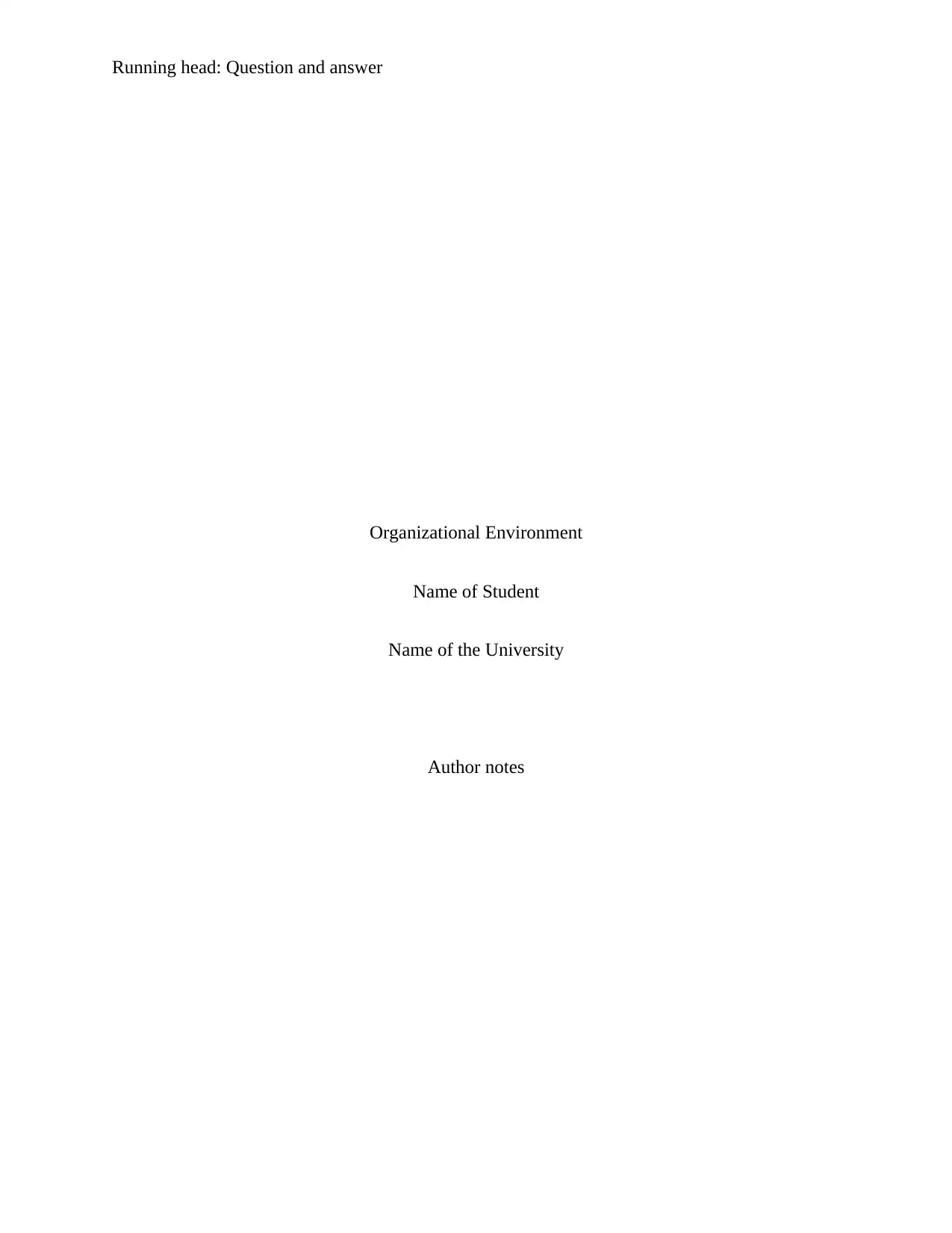
Running head: Question and answer
Organizational Environment
Name of Student
Name of the University
Author notes
Organizational Environment
Name of Student
Name of the University
Author notes
Paraphrase This Document
Need a fresh take? Get an instant paraphrase of this document with our AI Paraphraser
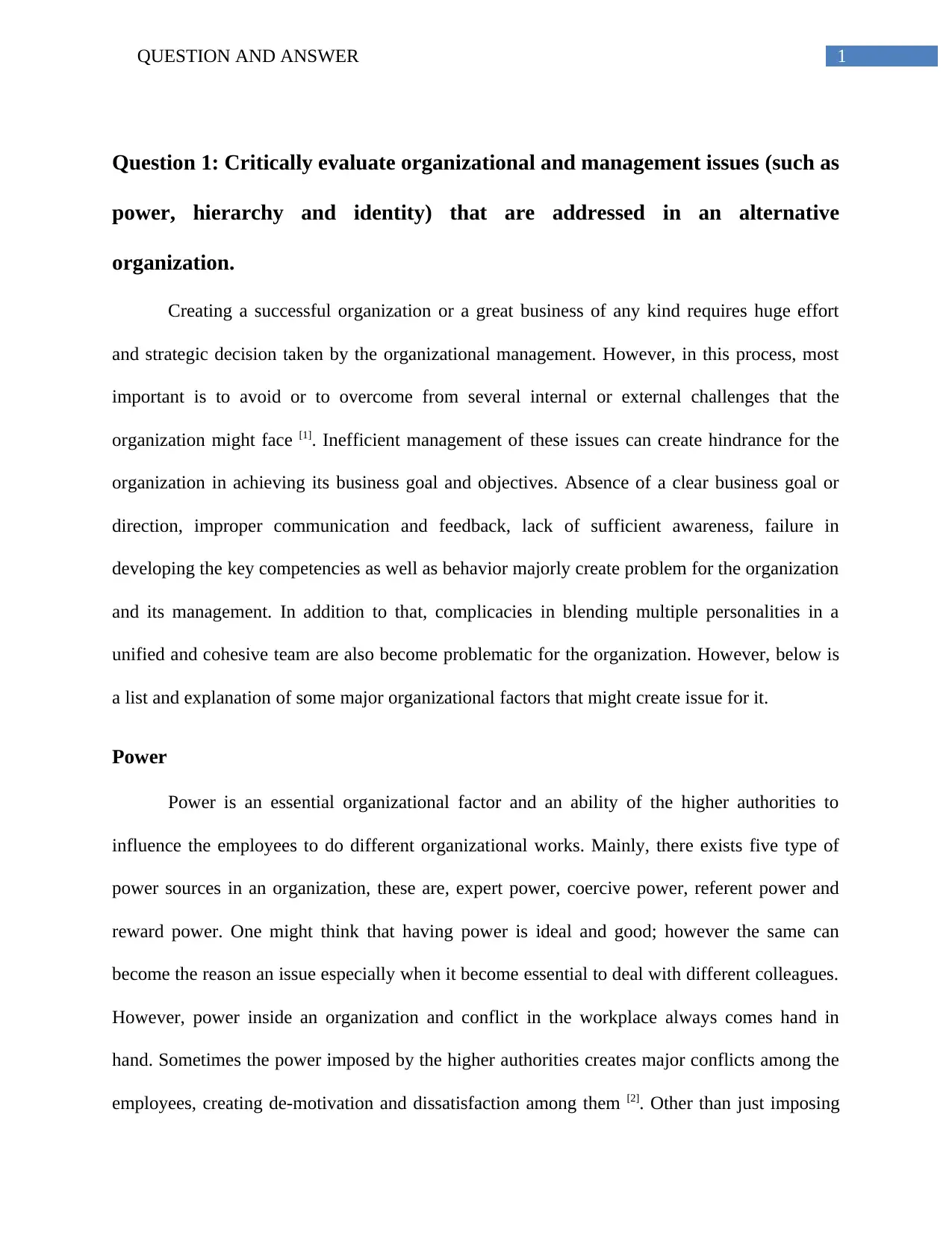
1QUESTION AND ANSWER
Question 1: Critically evaluate organizational and management issues (such as
power, hierarchy and identity) that are addressed in an alternative
organization.
Creating a successful organization or a great business of any kind requires huge effort
and strategic decision taken by the organizational management. However, in this process, most
important is to avoid or to overcome from several internal or external challenges that the
organization might face [1]. Inefficient management of these issues can create hindrance for the
organization in achieving its business goal and objectives. Absence of a clear business goal or
direction, improper communication and feedback, lack of sufficient awareness, failure in
developing the key competencies as well as behavior majorly create problem for the organization
and its management. In addition to that, complicacies in blending multiple personalities in a
unified and cohesive team are also become problematic for the organization. However, below is
a list and explanation of some major organizational factors that might create issue for it.
Power
Power is an essential organizational factor and an ability of the higher authorities to
influence the employees to do different organizational works. Mainly, there exists five type of
power sources in an organization, these are, expert power, coercive power, referent power and
reward power. One might think that having power is ideal and good; however the same can
become the reason an issue especially when it become essential to deal with different colleagues.
However, power inside an organization and conflict in the workplace always comes hand in
hand. Sometimes the power imposed by the higher authorities creates major conflicts among the
employees, creating de-motivation and dissatisfaction among them [2]. Other than just imposing
Question 1: Critically evaluate organizational and management issues (such as
power, hierarchy and identity) that are addressed in an alternative
organization.
Creating a successful organization or a great business of any kind requires huge effort
and strategic decision taken by the organizational management. However, in this process, most
important is to avoid or to overcome from several internal or external challenges that the
organization might face [1]. Inefficient management of these issues can create hindrance for the
organization in achieving its business goal and objectives. Absence of a clear business goal or
direction, improper communication and feedback, lack of sufficient awareness, failure in
developing the key competencies as well as behavior majorly create problem for the organization
and its management. In addition to that, complicacies in blending multiple personalities in a
unified and cohesive team are also become problematic for the organization. However, below is
a list and explanation of some major organizational factors that might create issue for it.
Power
Power is an essential organizational factor and an ability of the higher authorities to
influence the employees to do different organizational works. Mainly, there exists five type of
power sources in an organization, these are, expert power, coercive power, referent power and
reward power. One might think that having power is ideal and good; however the same can
become the reason an issue especially when it become essential to deal with different colleagues.
However, power inside an organization and conflict in the workplace always comes hand in
hand. Sometimes the power imposed by the higher authorities creates major conflicts among the
employees, creating de-motivation and dissatisfaction among them [2]. Other than just imposing
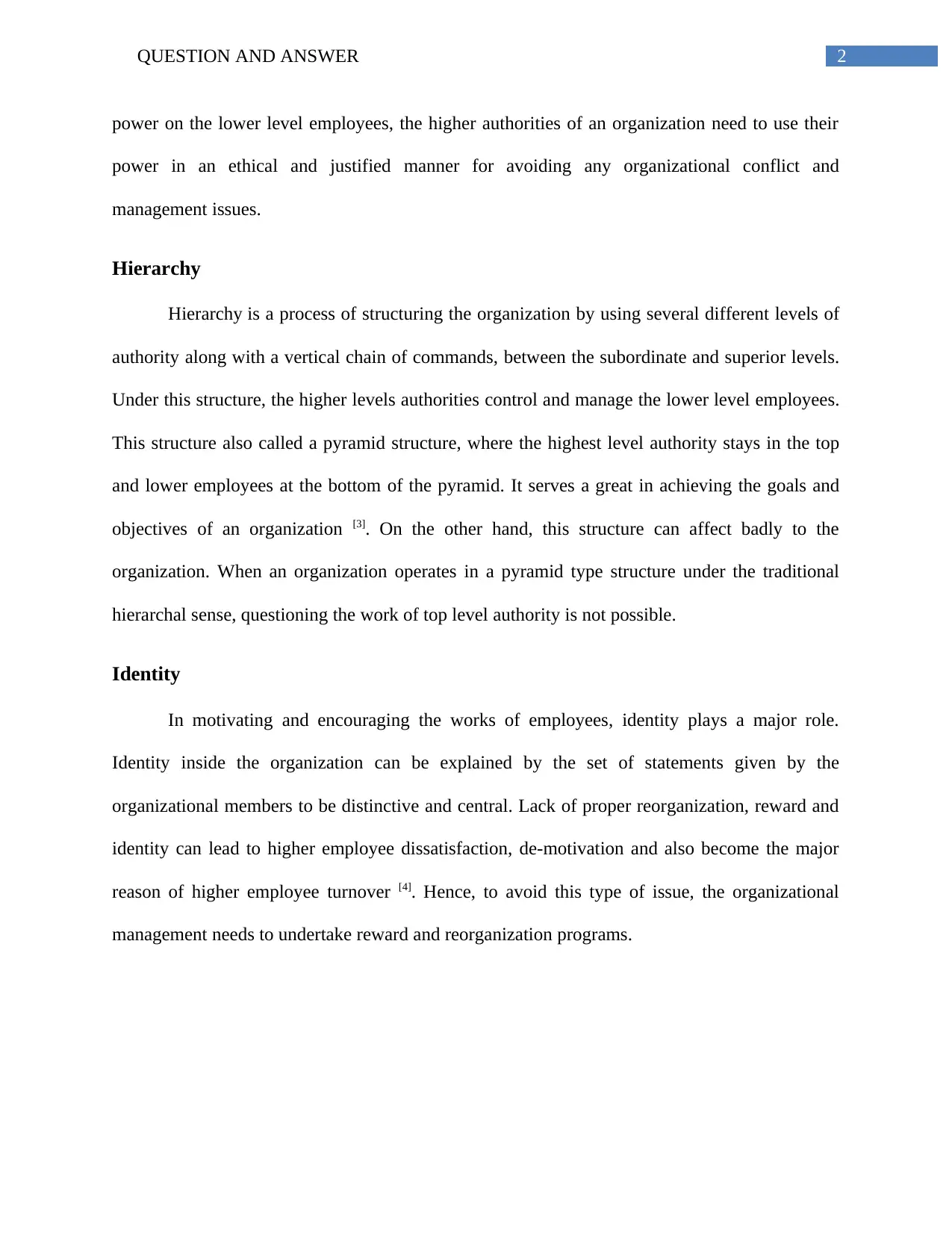
2QUESTION AND ANSWER
power on the lower level employees, the higher authorities of an organization need to use their
power in an ethical and justified manner for avoiding any organizational conflict and
management issues.
Hierarchy
Hierarchy is a process of structuring the organization by using several different levels of
authority along with a vertical chain of commands, between the subordinate and superior levels.
Under this structure, the higher levels authorities control and manage the lower level employees.
This structure also called a pyramid structure, where the highest level authority stays in the top
and lower employees at the bottom of the pyramid. It serves a great in achieving the goals and
objectives of an organization [3]. On the other hand, this structure can affect badly to the
organization. When an organization operates in a pyramid type structure under the traditional
hierarchal sense, questioning the work of top level authority is not possible.
Identity
In motivating and encouraging the works of employees, identity plays a major role.
Identity inside the organization can be explained by the set of statements given by the
organizational members to be distinctive and central. Lack of proper reorganization, reward and
identity can lead to higher employee dissatisfaction, de-motivation and also become the major
reason of higher employee turnover [4]. Hence, to avoid this type of issue, the organizational
management needs to undertake reward and reorganization programs.
power on the lower level employees, the higher authorities of an organization need to use their
power in an ethical and justified manner for avoiding any organizational conflict and
management issues.
Hierarchy
Hierarchy is a process of structuring the organization by using several different levels of
authority along with a vertical chain of commands, between the subordinate and superior levels.
Under this structure, the higher levels authorities control and manage the lower level employees.
This structure also called a pyramid structure, where the highest level authority stays in the top
and lower employees at the bottom of the pyramid. It serves a great in achieving the goals and
objectives of an organization [3]. On the other hand, this structure can affect badly to the
organization. When an organization operates in a pyramid type structure under the traditional
hierarchal sense, questioning the work of top level authority is not possible.
Identity
In motivating and encouraging the works of employees, identity plays a major role.
Identity inside the organization can be explained by the set of statements given by the
organizational members to be distinctive and central. Lack of proper reorganization, reward and
identity can lead to higher employee dissatisfaction, de-motivation and also become the major
reason of higher employee turnover [4]. Hence, to avoid this type of issue, the organizational
management needs to undertake reward and reorganization programs.
⊘ This is a preview!⊘
Do you want full access?
Subscribe today to unlock all pages.

Trusted by 1+ million students worldwide
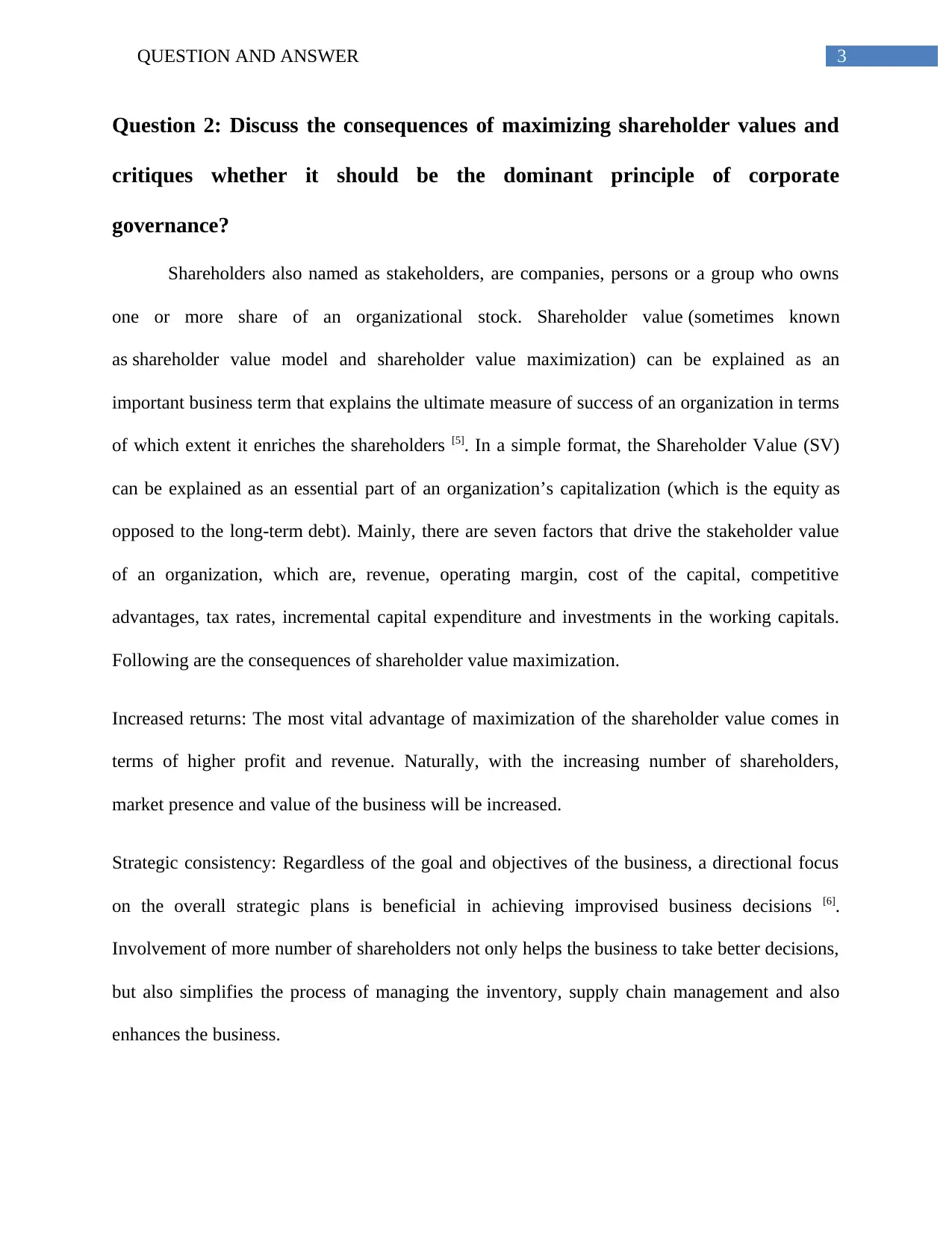
3QUESTION AND ANSWER
Question 2: Discuss the consequences of maximizing shareholder values and
critiques whether it should be the dominant principle of corporate
governance?
Shareholders also named as stakeholders, are companies, persons or a group who owns
one or more share of an organizational stock. Shareholder value (sometimes known
as shareholder value model and shareholder value maximization) can be explained as an
important business term that explains the ultimate measure of success of an organization in terms
of which extent it enriches the shareholders [5]. In a simple format, the Shareholder Value (SV)
can be explained as an essential part of an organization’s capitalization (which is the equity as
opposed to the long-term debt). Mainly, there are seven factors that drive the stakeholder value
of an organization, which are, revenue, operating margin, cost of the capital, competitive
advantages, tax rates, incremental capital expenditure and investments in the working capitals.
Following are the consequences of shareholder value maximization.
Increased returns: The most vital advantage of maximization of the shareholder value comes in
terms of higher profit and revenue. Naturally, with the increasing number of shareholders,
market presence and value of the business will be increased.
Strategic consistency: Regardless of the goal and objectives of the business, a directional focus
on the overall strategic plans is beneficial in achieving improvised business decisions [6].
Involvement of more number of shareholders not only helps the business to take better decisions,
but also simplifies the process of managing the inventory, supply chain management and also
enhances the business.
Question 2: Discuss the consequences of maximizing shareholder values and
critiques whether it should be the dominant principle of corporate
governance?
Shareholders also named as stakeholders, are companies, persons or a group who owns
one or more share of an organizational stock. Shareholder value (sometimes known
as shareholder value model and shareholder value maximization) can be explained as an
important business term that explains the ultimate measure of success of an organization in terms
of which extent it enriches the shareholders [5]. In a simple format, the Shareholder Value (SV)
can be explained as an essential part of an organization’s capitalization (which is the equity as
opposed to the long-term debt). Mainly, there are seven factors that drive the stakeholder value
of an organization, which are, revenue, operating margin, cost of the capital, competitive
advantages, tax rates, incremental capital expenditure and investments in the working capitals.
Following are the consequences of shareholder value maximization.
Increased returns: The most vital advantage of maximization of the shareholder value comes in
terms of higher profit and revenue. Naturally, with the increasing number of shareholders,
market presence and value of the business will be increased.
Strategic consistency: Regardless of the goal and objectives of the business, a directional focus
on the overall strategic plans is beneficial in achieving improvised business decisions [6].
Involvement of more number of shareholders not only helps the business to take better decisions,
but also simplifies the process of managing the inventory, supply chain management and also
enhances the business.
Paraphrase This Document
Need a fresh take? Get an instant paraphrase of this document with our AI Paraphraser
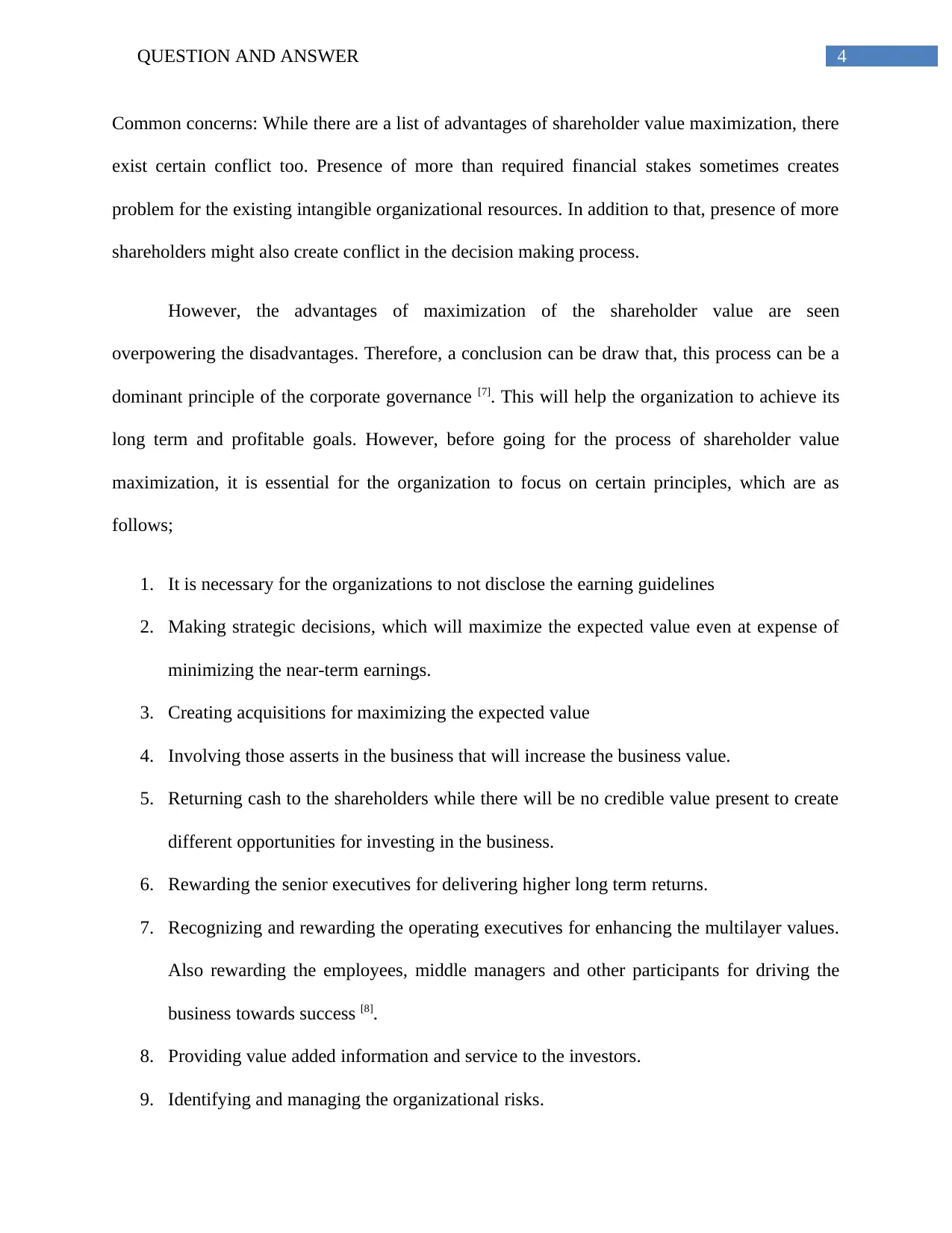
4QUESTION AND ANSWER
Common concerns: While there are a list of advantages of shareholder value maximization, there
exist certain conflict too. Presence of more than required financial stakes sometimes creates
problem for the existing intangible organizational resources. In addition to that, presence of more
shareholders might also create conflict in the decision making process.
However, the advantages of maximization of the shareholder value are seen
overpowering the disadvantages. Therefore, a conclusion can be draw that, this process can be a
dominant principle of the corporate governance [7]. This will help the organization to achieve its
long term and profitable goals. However, before going for the process of shareholder value
maximization, it is essential for the organization to focus on certain principles, which are as
follows;
1. It is necessary for the organizations to not disclose the earning guidelines
2. Making strategic decisions, which will maximize the expected value even at expense of
minimizing the near-term earnings.
3. Creating acquisitions for maximizing the expected value
4. Involving those asserts in the business that will increase the business value.
5. Returning cash to the shareholders while there will be no credible value present to create
different opportunities for investing in the business.
6. Rewarding the senior executives for delivering higher long term returns.
7. Recognizing and rewarding the operating executives for enhancing the multilayer values.
Also rewarding the employees, middle managers and other participants for driving the
business towards success [8].
8. Providing value added information and service to the investors.
9. Identifying and managing the organizational risks.
Common concerns: While there are a list of advantages of shareholder value maximization, there
exist certain conflict too. Presence of more than required financial stakes sometimes creates
problem for the existing intangible organizational resources. In addition to that, presence of more
shareholders might also create conflict in the decision making process.
However, the advantages of maximization of the shareholder value are seen
overpowering the disadvantages. Therefore, a conclusion can be draw that, this process can be a
dominant principle of the corporate governance [7]. This will help the organization to achieve its
long term and profitable goals. However, before going for the process of shareholder value
maximization, it is essential for the organization to focus on certain principles, which are as
follows;
1. It is necessary for the organizations to not disclose the earning guidelines
2. Making strategic decisions, which will maximize the expected value even at expense of
minimizing the near-term earnings.
3. Creating acquisitions for maximizing the expected value
4. Involving those asserts in the business that will increase the business value.
5. Returning cash to the shareholders while there will be no credible value present to create
different opportunities for investing in the business.
6. Rewarding the senior executives for delivering higher long term returns.
7. Recognizing and rewarding the operating executives for enhancing the multilayer values.
Also rewarding the employees, middle managers and other participants for driving the
business towards success [8].
8. Providing value added information and service to the investors.
9. Identifying and managing the organizational risks.
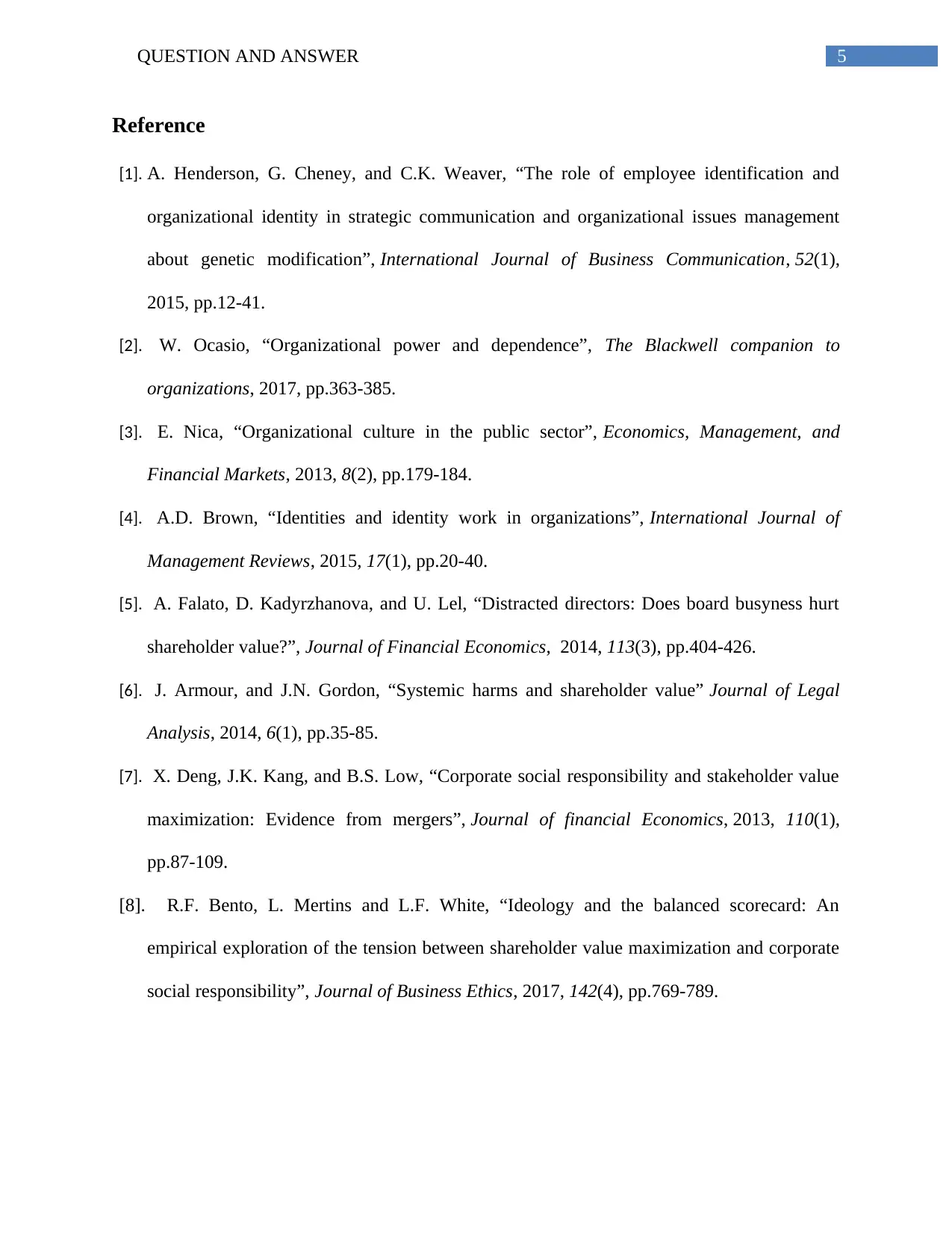
5QUESTION AND ANSWER
Reference
[1]. A. Henderson, G. Cheney, and C.K. Weaver, “The role of employee identification and
organizational identity in strategic communication and organizational issues management
about genetic modification”, International Journal of Business Communication, 52(1),
2015, pp.12-41.
[2]. W. Ocasio, “Organizational power and dependence”, The Blackwell companion to
organizations, 2017, pp.363-385.
[3]. E. Nica, “Organizational culture in the public sector”, Economics, Management, and
Financial Markets, 2013, 8(2), pp.179-184.
[4]. A.D. Brown, “Identities and identity work in organizations”, International Journal of
Management Reviews, 2015, 17(1), pp.20-40.
[5]. A. Falato, D. Kadyrzhanova, and U. Lel, “Distracted directors: Does board busyness hurt
shareholder value?”, Journal of Financial Economics, 2014, 113(3), pp.404-426.
[6]. J. Armour, and J.N. Gordon, “Systemic harms and shareholder value” Journal of Legal
Analysis, 2014, 6(1), pp.35-85.
[7]. X. Deng, J.K. Kang, and B.S. Low, “Corporate social responsibility and stakeholder value
maximization: Evidence from mergers”, Journal of financial Economics, 2013, 110(1),
pp.87-109.
[8]. R.F. Bento, L. Mertins and L.F. White, “Ideology and the balanced scorecard: An
empirical exploration of the tension between shareholder value maximization and corporate
social responsibility”, Journal of Business Ethics, 2017, 142(4), pp.769-789.
Reference
[1]. A. Henderson, G. Cheney, and C.K. Weaver, “The role of employee identification and
organizational identity in strategic communication and organizational issues management
about genetic modification”, International Journal of Business Communication, 52(1),
2015, pp.12-41.
[2]. W. Ocasio, “Organizational power and dependence”, The Blackwell companion to
organizations, 2017, pp.363-385.
[3]. E. Nica, “Organizational culture in the public sector”, Economics, Management, and
Financial Markets, 2013, 8(2), pp.179-184.
[4]. A.D. Brown, “Identities and identity work in organizations”, International Journal of
Management Reviews, 2015, 17(1), pp.20-40.
[5]. A. Falato, D. Kadyrzhanova, and U. Lel, “Distracted directors: Does board busyness hurt
shareholder value?”, Journal of Financial Economics, 2014, 113(3), pp.404-426.
[6]. J. Armour, and J.N. Gordon, “Systemic harms and shareholder value” Journal of Legal
Analysis, 2014, 6(1), pp.35-85.
[7]. X. Deng, J.K. Kang, and B.S. Low, “Corporate social responsibility and stakeholder value
maximization: Evidence from mergers”, Journal of financial Economics, 2013, 110(1),
pp.87-109.
[8]. R.F. Bento, L. Mertins and L.F. White, “Ideology and the balanced scorecard: An
empirical exploration of the tension between shareholder value maximization and corporate
social responsibility”, Journal of Business Ethics, 2017, 142(4), pp.769-789.
⊘ This is a preview!⊘
Do you want full access?
Subscribe today to unlock all pages.

Trusted by 1+ million students worldwide

6QUESTION AND ANSWER
1 out of 7
Related Documents
Your All-in-One AI-Powered Toolkit for Academic Success.
+13062052269
info@desklib.com
Available 24*7 on WhatsApp / Email
![[object Object]](/_next/static/media/star-bottom.7253800d.svg)
Unlock your academic potential
Copyright © 2020–2025 A2Z Services. All Rights Reserved. Developed and managed by ZUCOL.





